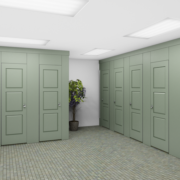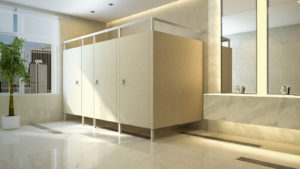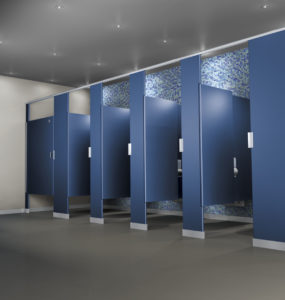When designing and building a new facility or upgrading one, taking advantage of new concepts and designs will lead to more comfort for your patrons and a facility that doesn’t negatively impact the world around you.
Certain products and materials that you use to build your facility can have a significantly negative or a significantly positive impact on the world you live in, and you want to be sure that you know which way your building concepts and designs will lead. However, you can be certain of this when you get LEED certification for your facility, and we’re here to show you how.
What Is LEED Certification?
LEED certification for your facility’s restroom or locker room ensures that the products and building concepts you choose live up to beneficial environmental standards. For example, LEED certification makes note of using sustainable building materials that reduce waste because they’re created with recycled materials and can be recycled as well. LEED certification also promotes water efficiency, good air quality, construction approaches, and sites that are sustainable and don’t negatively impact the ecosystem.
Why Do I Need LEED Certification for My Buildings?
When you embrace the requirements of LEED certification, you work to promote a more environmentally friendly facility. Each step you take toward a more sustainable facility, the more points you’ll receive towards LEED certification. And if you receive said certification, your facility will be recognized as clean, environmentally friendly, and sanitary.
Certification from LEED is globally viewed as the premier mark of achievement for a sustainable building, which goes a long way for your business with customers.
How Can Scranton Products Help My LEED Score?
Many times green opportunities can be missed when designing your facility. A majority of the facility managers working to create an environmentally friendly building only focus on reducing the amount of water, energy, or heat produced by the facility.
While this is a deserving focus, spending all of your efforts on those elements makes it easier to miss out on some green opportunities that you’ll need to increase your LEED score so it can be considered certifiable.
Scranton Products can help your facility or business become LEED certified by working with you to incorporate environmentally friendly materials into your restrooms or locker rooms. Whether it’s new lockers, bathroom partitions, or sink vanities, our HDPE plastic materials tend to fly under the radar as a green opportunity but support a healthier environment and help to reduce the total amount of industrial waste.
HDPE materials from Scranton Products are made from post-consumer recycled content and are 100% recyclable on their own. By using these materials in your building concepts and designs, you’ll be that much closer to receiving LEED certification and being recognized by a leading environmental company as having a green building.
You can find out where you can purchase Scranton Product materials near you.



 Another major benefit to utilizing a sustainable material like HDPE plastic is that this material doesn’t require any painting. If graffiti somehow shows up, your first instinct is to get a paint match to cover over the drawing; however, with HDPE, you can simply wipe away the marker or spray paint. Since HDPE is non-absorbent, you don’t have to buy additional paint and perform any touch-ups. Due to the lack of repainting, you won’t be exposing your restroom, or its occupants, to the harmful VOC (volatile organic compounds) that are present in most paints.
Another major benefit to utilizing a sustainable material like HDPE plastic is that this material doesn’t require any painting. If graffiti somehow shows up, your first instinct is to get a paint match to cover over the drawing; however, with HDPE, you can simply wipe away the marker or spray paint. Since HDPE is non-absorbent, you don’t have to buy additional paint and perform any touch-ups. Due to the lack of repainting, you won’t be exposing your restroom, or its occupants, to the harmful VOC (volatile organic compounds) that are present in most paints.